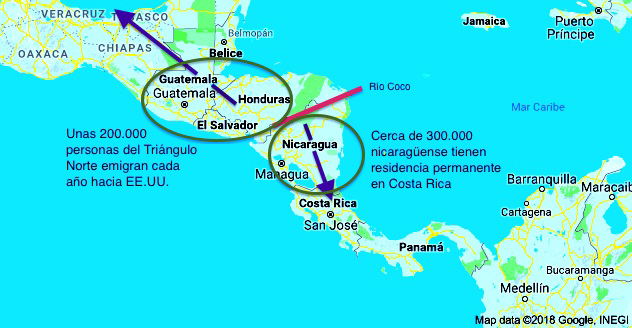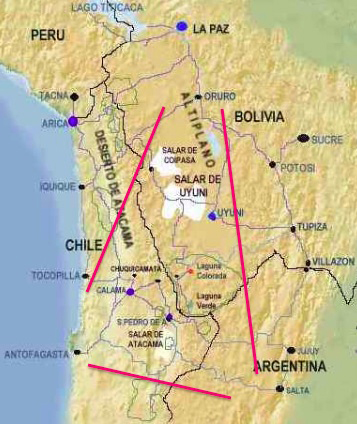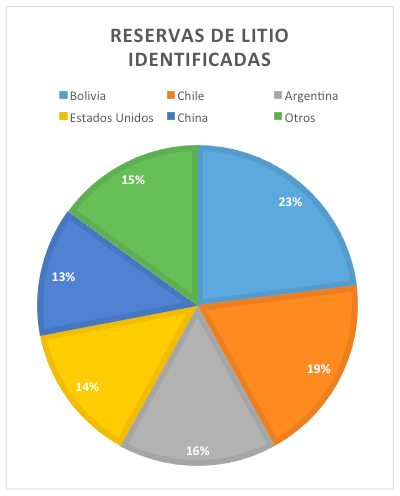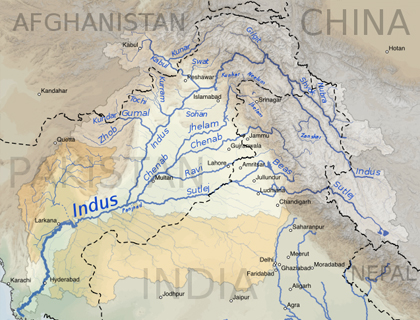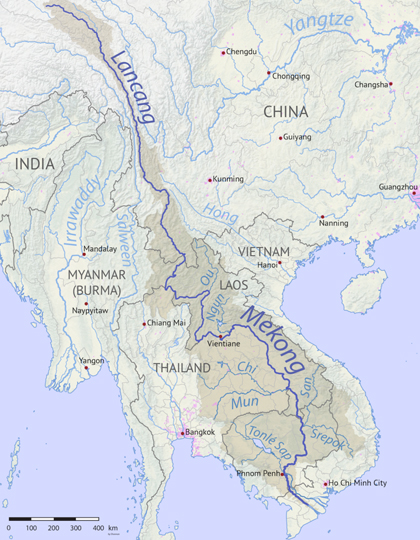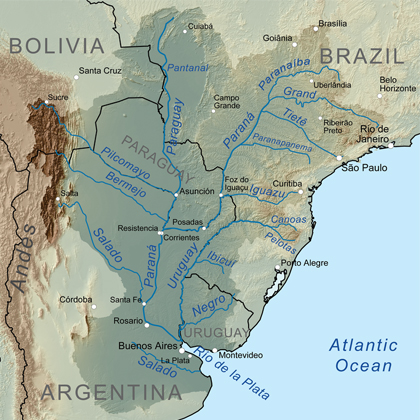Ruta de navegación
Menú de navegación
Blogs
Entries with Categories Global Affairs Latin America .
Central America's Northern Triangle migrants look to the U.S., Nicaragua's to Costa Rica
While migrants from Guatemala, El Salvador and Honduras continue to try to reach the United States, those from Nicaragua have preferred to travel to Costa Rica in recent years. The restrictions put in place by the Trump Administration and the deterioration of the Costa Rican economic boom are reducing the flows, but this migratory divide in Central America remains for the time being.
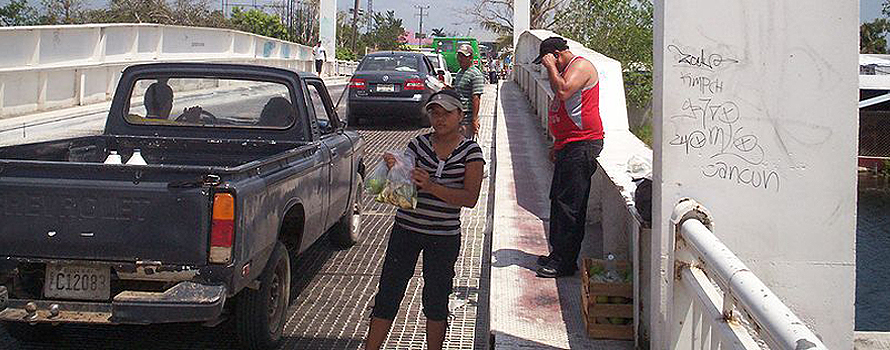
▲Belize-Mexico border crossing [Marrovi/CC].
article / Celia Olivar Gil
When comparing the Degree of development of the Central American countries, the different human flows operating in the region are well understood. The United States is the great migratory magnet, but Costa Rica is also to some extent a pole of attraction, evidently to a lesser extent Degree. Thus, the five Central American countries with the highest poverty rates -Guatemala, El Salvador, Honduras, Nicaragua and Belize- share their migratory orientation: the first four maintain important flows to the United States, while in recent years Nicaragua has opted more for Costa Rica, given its proximity.
Migration from the Northern Triangle to the U.S.
Nearly 500,000 people try every year to cross Mexico's southern border with the goal to reach the United States. Most of them come from Guatemala, El Salvador and Honduras, the Central American region known as the Northern Triangle, which is currently one of the most violent in the world. The reasons that lead this high issue number of citizens from the Northern Triangle to migrate, many illegally, are various:
On the one hand, there are reasons that could be described as structural: the porousness of the border, the complexity and high costs of regularization processes for migration, the lack of commitment by employers to regularize migrant workers, and the insufficient capacity of governments to establish migration laws.
There are also clear economic reasons: Guatemala, Honduras and El Salvador have high poverty rates, at 67.7%, 74.3% and 41.6%, respectively, of their inhabitants. presentation Difficulties in budgetary income and pronounced social inequality mean that public services, such as Education and healthcare, are deficient for a large part of the population.
Perhaps the most compelling reason is the lack of security. Many of those leaving these three countries cite insecurity and violence as the main reason for their departure. The level of criminal violence in the Northern Triangle reaches levels similar to those of an armed conflict. In El Salvador, a total of 6,650 intentional homicides were registered in 2015; in Honduras, 8,035, and in Guatemala, 4,778.
All these reasons push Guatemalans, Salvadorans and Hondurans to migrate to the United States, who on their journey north use three main routes to cross Mexico: the one that crosses the country diagonally until reaching the area of Tijuana, the one that advances through central Mexico to Ciudad Juarez and the one that seeks to enter the US through the Rio Bravo valley. subject Along these routes, migrants face many risks, such as falling victim to criminal organizations and suffering all kinds of abuses (kidnapping, torture, rape, robbery, extortion...), which can not only cause immediate physical injuries and trauma, but can also leave serious long-term consequences deadline.
Despite all these difficulties, citizens of the Northern Triangle continue to choose the United States as their migration destination. This is mainly due to the attraction of the economic potential of a country like the USA, at status of plenary session of the Executive Council employment ; to its relative geographic proximity (it is possible to arrive by land crossing only one or two countries), and to the human relations created since the 1980s, when the USA began to be goal for those fleeing the civil wars of a politically unstable Central America with economic difficulties, which created a migratory tradition, consolidated by family connections and the protection offered to the newcomers by the already established nationals. During this period, the Central American population in the U.S. tripled. Today, 82.9% of Central American immigrants in the U.S. live in the United States.
|
The American immigration 'watershed' [with ABC's authorization]. |
Migration from Nicaragua to Costa Rica
If emigration from northern Central America has been directed towards the United States, emigration from southern Central America has had more destinations. If Hondurans have looked to the north, in recent years their Nicaraguan neighbors have looked somewhat more to the south. The Coco River, which divides Honduras and Nicaragua, has become a sort of migratory'watershed'.
Certainly there are more Nicaraguans officially residing in the U.S. (over 400,000) than in Costa Rica (close to 300,000), but in recent years the issue of new residents has increased more in Costa Rican territory. In the last decade, from agreement with an OAS report (pages 159 and 188), the US has granted permanent residency program permission to a average of 3,500 Nicaraguans each year, while Costa Rica has granted about 5,000 from average, reaching a record 14,779 in 2013. Moreover, the proportional weight of Nicaraguan migration in Costa Rica, a country of 4.9 million inhabitants, is large: in 2016, some 440,000 Nicaraguans entered the neighboring country, and as many exits were recorded, indicating a significant cross-border mobility and suggesting that many workers temporarily return to Nicaragua to circumvent the requirements de extranjería.
Costa Rica is seen in certain aspects in Latin America as Switzerland in Europe, that is, as an institutionally solid, politically stable and economically favorable country. This means that the emigration of Costa Ricans is not extreme and that people come from other places, so that Costa Rica is the country with the highest net migration in Latin America, with 9% of the Costa Rican population of foreign origin.
Since its independence in the 1820s, Costa Rica has remained one of the Central American countries with the least amount of serious conflicts. For this reason, during the 1970s and 1980s it was a refuge for many Nicaraguans fleeing the Somoza dictatorship and the Sandinista revolution. Now, however, they do not emigrate for security reasons, since Nicaragua is one of the least violent countries in Latin America, even below Costa Rica's figures. This migratory flow is due to economic reasons: Costa Rica's higher development is reflected in the poverty rate, which is 18.6%, compared to Nicaragua's 58.3%; in fact, Nicaragua is the poorest country in the Americas after Haiti.
Likewise, Nicaraguans have a special preference for choosing Costa Rica as a destination because of its geographic proximity, which allows them to move frequently between the two countries and to maintain to a certain extent family coexistence; the use of the same language, and other cultural similarities.
[Omar Jaén Suárez, 500 years of the Pacific Basin. Towards a global history. Ediciones Doce Calles, Aranjuez 2016, 637 pages]
review / Emili J. Blasco
In just thirty years, between Columbus' arrival in America in 1492 and Elcano's return to Cadiz after his round-the-world voyage in 1522, Spain added to its domain not only a new continent, but also a new ocean. We all know about Spain's Atlantic dimension, but we often disregard its peaceful dimension. During the sixteenth and early seventeenth centuries, the Pacific Ocean was primarily under Spanish dominion. Spain was the European power present for the longest time and with the greatest weight in the entire basin of what began to be called the South Sea. Spain was the first navy that regularly patrolled its waters - the Armada del Sur, based in El Callao, Peru - and Spain was the first trade route that periodically crossed it from side to side - the Manila galleon, between the Philippines and Mexico.
 |
In "500 years of the Pacific Basin. Toward a global history", Panamanian diplomat and historian Omar Jaén Suárez does not limit himself to documenting that Spanish and then Hispanic presence in a vast space -one third of the Earth's sphere and half of its waters- whose eastern margin is the coast of Spanish America. As degree scroll indicates, his is a global history. But to approach the last half millennium means that it starts from the fact that the Spanish conquered the Pacific Ocean and that this is a global history. finding of the Pacific by the Spaniards and that determines the approach of the narration.
If Anglo-Saxon historiography would have perhaps used another prism, in this book the accent is placed on the development of the entire Pacific account from the arrival of the first Europeans, with Nuñez de Balboa at the head. Without forgetting the colonizing facts of other powers, the author details aspects that the Spanish do forget, such as the permanent base that Spain had in Formosa (today Taiwan), the attempts of the Crown to keep Tahiti or the voyages through Alaska in search of a sea passage to the north of America, which had as a logistic point the island of Quadra and Vancouver, the great Canadian city today known only by the second part of that name (in fact, Spain neglected to populate Oregon, more interested in the Philippines and trade with the Moluccas): quite a pioneering "turn to Asia").
Being from Panama gives Omar Jaén, who has also lived in Spain, a special sensitivity for his subject study. The Panamanian isthmus has always been the key to the South Sea for the Old World; with the construction of the canal, Panama is also a transit point between East and West.
The careful edition of this work adds an indisputable value. Almost eight hundred maps, graphs, engravings and photographs make it especially visual. The quantity of illustrations, many in full color, and the good weight of the paper make the volume thicker, in a printing that constitutes a luxury for anyone interested in the Pacific. Ediciones Doce Calles has taken great care with this first degree scroll of a new collection, Pictura Mundi, dedicated to celebrating travels, explorations and geographical discoveries.
Domestic demand will increase, unlike in more advanced regions
In the coming decades, oil consumption in Latin America will continue to grow, in the face of a trend towards leave which is already on the horizon of many advanced countries. Population growth and the increase in class average explains this increase in demand. This domestic demand will serve to strengthen the extractive industries of Latin American crude oil producers, but it will make the region's refining deficit chronic.

article / Ignacio Urbasos
The oil industry is experiencing a change in export and consumption patterns in the Latin American region. The sector's classic orientation towards the United States has changed in a new context in which exports are much more diversified with a tilt towards emerging Asian countries. Similarly, domestic demand is steadily increasing due to population and economic growth. However, the region's refining capacity will remain inadequate. This paper will offer a long-term analysis to try to offer a better understanding of the region's energy future, mainly in its consumption, extraction and subsequent refinement.
First of all, Latin America's demographic and economic expectations must be taken into account: population growth will increase by 800 million people by 2050, and economic growth could be 2% per year for at least the next decade. The direct effect of this will be the increase in electricity demand by 91% by 2040 and the increase in issue of vehicles in the region from 94 million in 2016 to the 165 million expected by 2040.
As can be seen in the graph below, the greater demand for oil in the region will be associated with transport, which will tend to be more efficient in consumption, but the promised arrival of the electric car is still far away, with expectations of less than 4% by 2030 worldwide. Similarly, the increase in the class average 126 million people by 2030 will have a direct impact on the increase in air travel, which is projected to grow by average 3.4% per annum until 2034, agreement to the last report of ICAO, with a consequent increase in kerosene consumption.
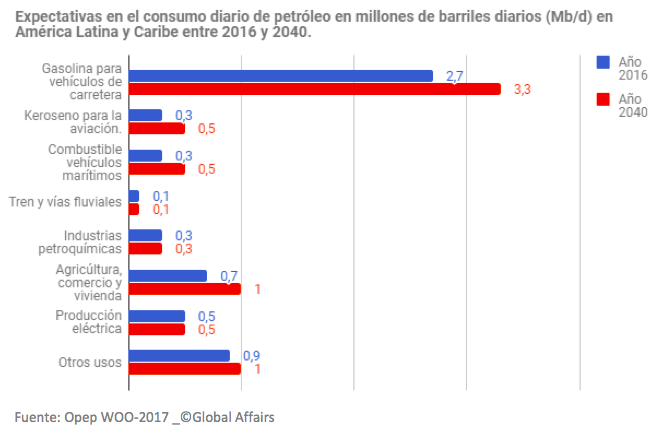 |
It should be borne in mind that in Latin America there are subsidies for both gasoline and diesel, which generates more affordable prices and distorts demand clearly upwards. These subsidies respond mainly to the logic that citizens should be beneficiaries of their country's possession of natural resources, and are concentrated in traditionally oil-producing countries such as Ecuador, Venezuela, Mexico or Argentina. However, these countries import fuel to a large extent due to their limited refinery capacity, generating a double trade and fiscal deficit, as ECLAC points out. The future of these subsidies is unknown, but any change would have a high political cost, since by affecting the price of a basic good it would have consequences on broad social sectors with great electoral impact.
For its part, oil's contribution to electricity generation will remain constant at 500,000 barrels per day, decreasing its importance from the current 46%, according to figures for Latin America from the International Renewable Energy Agency. The region will benefit enormously from the increased presence of renewable energies, a sector that it already leads due to incomparable geographical conditions, highlighting the enormous importance of hydropower.
Over the next few decades, two major phenomena will occur in Latin America: the universalization of access to energy and a new model energy with less presence of oil and biofuel (wood and waste) in favour of gas and alternative energies. One of the great challenges facing the region is to develop a more integrated electricity system nationally and internationally that increases consumption efficiency and allows greater flexibility in production sources. The geographical uniqueness of the region requires enormous investments to carry out this task; however, there are already several regional projects in this direction: the Andean Electrical Interconnection System, which includes the countries of the Andean Community plus Chile, and the Central American Electrical Interconnection System (SIEPAC).
Refining deficit
This increase in consumption is not accompanied by greater refinery capacity, which is already enormously deficient, and generates a critical dependence on imports of gasoline and other derivatives from the US. A trend that is likely to be a constant in the short and medium term for the region and is added to the 14% decline in refinery activity in the region since 2012 (World Oil Outlook 2017), which already adds up to a loss of one million refined barrels per day since that year. High installation and maintenance costs, around 2% of the annual installation cost, add to the region's chronic political uncertainty that largely scares away private investment.
An illustrative case is that of the Pacific refinery in Ecuador, which was presented as the largest project refinery in the country at the beginning of Rafael Correa's presidency in 2007. The project began with a financial stake of 49% by PDVSA and 51% by Petroecuador, in addition to the award of the project to the construction company Odebrecht. As of today, PDVSA has withdrawn its contribution and the Brazilian construction company is facing trials in the country for corruption. result a lost decade and forcing Lenin Moreno to reformulate the project, including the name: now Manabi Refinery.
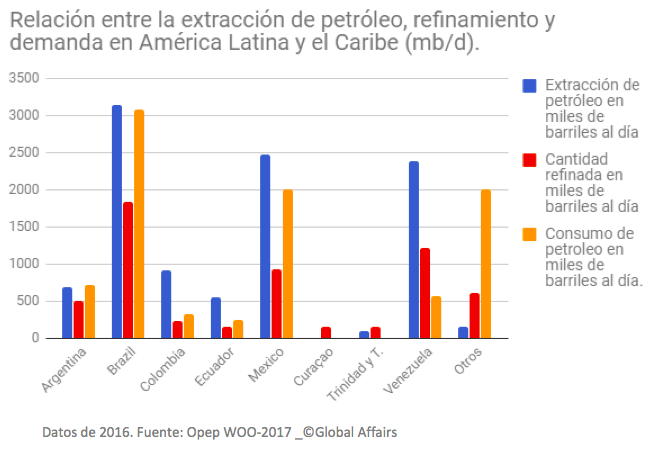 |
As we can see in the graph, the large oil producers in Latin America have a deficient refinery capacity. It should be borne in mind that there is not only an undercapacity in the region, but also an under-activity, which creates an even greater gap. The activity of these plants is currently around 70% of their total capacity. Those countries that do not have oil production, but do have a relevant refining industry, are Curaçao, which has one of the largest PDVSA centers, Chile and Peru.
In final, the Latin American oil sector faces the coming decades with enormous doubts about its refining capacity and far from achieving self-sufficiency. The lack of capacity to attract foreign investment from historically oil-producing countries has generated a disappointing scenario that aggravates the already limited industry in the region. The social transformations inherent in a society that is growing demographically and economically require investment in infrastructure in order to meet the expectations of universal access to education. network and the incipient consumption of the incipient class average.
Taiwan imports up to four times more than China from Central American countries that recognize it as a state.
Of the almost two hundred countries in the world, only 19 have diplomatic relations with Taiwan (and therefore do not have diplomatic relations with China). Of these, five are in Central America and four in the Caribbean. The recognition of Taipei has some advantages for these countries, although they have been neutralized by China's commercial weight. Panama established relations with Beijing in 2017 and the Dominican Republic has just done so now. Here we examine the interest that preference for Taiwan still holds for certain Central American countries.
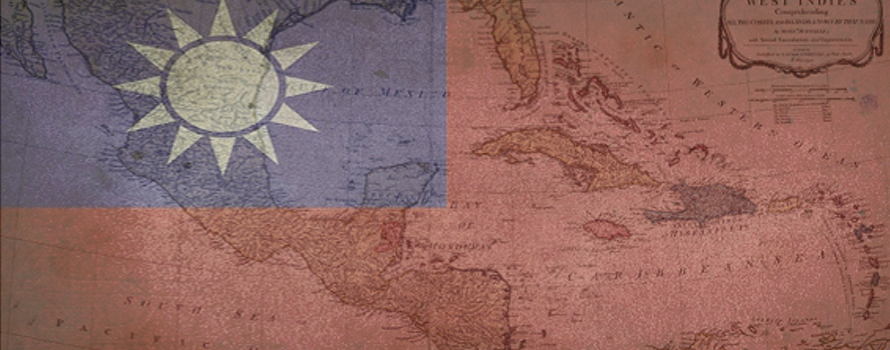
article / Blanca Abadía Moreno
Taiwan's special relationship with Central America dates back to the period following Taiwan's 1971 departure from the United Nations, where Nationalist China was displaced by the People's Republic of China. Several Latin American countries had established relations with Taiwan in the 1960s, but most of them gradually came to recognize Beijing after the UN change. Taiwan retained, however, the support of the Central American nations and in the 1980s also gained the support of small Caribbean islands that then became independent.
The emergence of China as a major international trade partner has been subtracting diplomatic recognition from Taiwan. Costa Rica established full ties with China in 2007, Panama in 2017 and the Dominican Republic last May 1. Even so, of the 19 countries that continue to opt for Taipei over Beijing, five are in Central America: Guatemala, Belize, Honduras, El Salvador and Nicaragua (this country with a five-year hiatus, from 1985-1990). Four others are in the Caribbean: Haiti and three tiny nations in the Lesser Antilles. If one takes into account that the rest of the countries that recognize Taiwan are of little commercial importance, except for Paraguay (they are the Vatican, Burkina Faso, Swaziland and six Polynesian microstates), it is understandable that Central America absorbs Taiwan' s diplomatic interest.
Since the constitutive theory of statehood defines a state as a person in international law if, and only if, it is recognized as sovereign by others, Taiwan strives to ensure that those countries continue to recognize it as a subject of plenary session of the Executive Council law in the concert of nations; losing their support would directly affect the legitimacy of its claims as a sovereign state.
To this end, Taipei promotes trade relations with them, procures investments and uses what is called "checkbook diplomacy": submission of gifts (and bribes) to maintain these relations. Central American countries receive an average of $50 million annually in declared non-reimbursable cooperation. Taiwan directs financial aid to its Latin American partners through the development and International Cooperation Fund(ICDF), with programs ranging from infrastructure construction to coffee production. Taiwan has financed and constructed several government buildings in Nicaragua and El Salvador.
In addition, the Asian nation contributes to programs of the Central American Bank for Economic Integration (CABEI) and is an observer country in the Central American Parliament and other regional organizations.
This effort, however, has not prevented that in recent years there have been casualties among Central American countries that saw him giving diplomatic recognition. Costa Rica's economic development led the country in 2007 to want to improve its trade figures through a rapprochement with China, which involved the opening of an embassy in Beijing and the closure of the one it had in Taipei. For the same reason, Panama also opted in 2017 to break off diplomatic relations with Taiwan, stating that China, a prominent Username of the Panamanian canal, "has always played a relevant role in Panama's Economics " and any restrictions preventing it from remaining so had to be removed.
 |
Commercial relations
Trade relations between Taiwan and the Central American countries that recognize it as a State increased significantly thanks to the opening of the Central American Trade Office(CATO) in Taiwan in 1997, the incorporation of this country into CABEI and the entrance entry into force of several trade agreements. Taiwan signed free trade agreements with Guatemala (2006), with Honduras and El Salvador (2006) and with Nicaragua (2008).
These treaties have especially facilitated Central American exports to Taiwan. As is the case with most Latin American countries, Guatemala, El Salvador, Honduras and Nicaragua have China as one of the main origins of their imports (the first is still the United States). Their political alignment with Taiwan does not prevent them from being customers of Chinese production. Thus, in 2016, China ranked between 2nd and 3rd as a source market, while Taiwan ranked far down the table (between 14th and 23rd). However, the special relationship with Taipei means that Taiwan equals or surpasses China as a destination for the exports of the four Central American countries mentioned. This is the commercial benefit they obtain from the diplomatic recognition of the Asian island.
Of this group of countries, Nicaragua exported the most to Taiwan in 2016 (US$83.7 million) compared to exports to China (US$21.5 million), a ratio of four to one. The main Nicaraguan products exported were shrimp, sugar, beef and coffee.
Honduras exported US$24.7 million to Taiwan -mainly textiles, coffee and aluminum- compared to US$18.5 million to China. El Salvador sent shipments to Taiwan worth US$53.3 million - mainly sugar - and US$46.5 million to China. Guatemala, whose Economics has a larger volume, was the only country to sell more to China (75.5 million), but in figures very similar to those of Taiwan (74 million), to which it sent mainly coffee, paper and cardboard.
With these diplomatic and commercial relations Taiwan intends to show international society that it is a capable ally and manager for international cooperation. It also wants to show the world that Taiwanese diplomacy exists despite China's attempts to isolate it. The fact that China has a special interest in markets that facilitate access to raw materials makes the Asian giant more attentive to relations with several South American countries, rich in minerals; it is there where Beijing concentrates its Latin American investments.
Central America, with less extractive activity, thus escapes China's priority (the interest in the Panama Canal is a case apart), and is left for the time being to Taiwan's action. However, the increasingly residual nature of support for the island and the very weight of relations with China suggest that the Central American countries will continue to join this particular club, one after the other, from leave.
Nearly two-thirds of the world's identified lithium reserves are in Bolivia, Chile and Argentina
The explosion of the electric automotive industry through the use of lithium-ion batteries has put the large reserves of this metal in the Bolivian highlands and the Atacama Desert at the center of global interest in this new industry. Will South America take advantage of the opportunity to enter into processes of technological innovation itself, or will it resign itself, as has happened with so many other minerals, to a mere work of extraction?
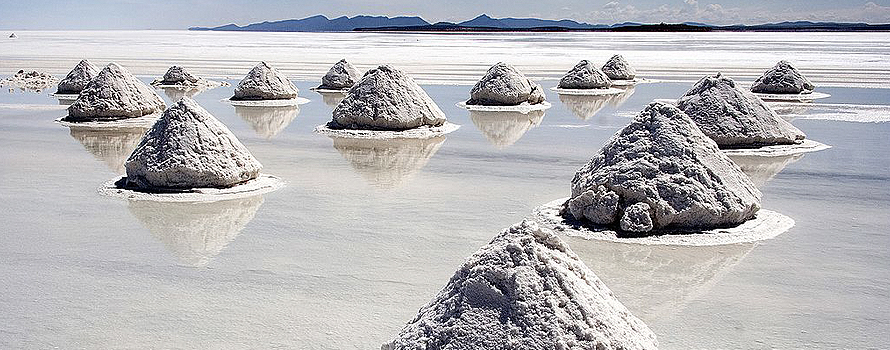
▲Salar de Uyuni, in the highlands of Bolivia [Luca Galuzzi, Wikimedia Commons]
article / Milene Pardo-Figueroa
With the gradual introduction of electric vehicles into the market, as well as the increase in the sale of smartphones, laptops, tablets and other electronic devices – all of which are powered by lithium-ion batteries – the global demand for lithium is increasing. This alkaline chemical element, which in its pure form occurs as a soft, particularly light metal, is abundant in nature, although the largest reserves are concentrated in a few countries. Due to the conditions of its extraction, it is especially profitable in the dry areas of the triangle bounded by the borders of Bolivia, Chile and Argentina. If lithium is known as "white oil" or "new gasoline", because of the color of the saltpeter of the deposits where it is found and because it is the driving force of modern automobiles, the border area of these countries is called the "Saudi Arabia of lithium".
The lithium "fever" has led to a current production of 40,000 tonnes per year, a figure that falls short of the huge demand that currently poses a need of 180,000 tonnes. Although this volume may be reached in the coming years, estimates speak of a demand of between 500,000 and 800,000 tons in 2025. By then, agreement With some forecasts, the global lithium battery market could be worth $46 billion. Part of the industry's push comes from the innovation of electric cars. The expansion of that market, however, could be slowed if lithium production is not accelerated. As visionary entrepreneur Elon Musk, promoter of the high-end electric car brand Tesla, has warned, "in order to create 500,000 vehicles a year, we basically have to retain all the lithium generation on the planet."
The difficulty in meeting this growing demand comes from the high extraction costs, which vary considerably depending on the characteristics of the deposit. The most profitable deposits are found in brine concentrates in arid climates, which experience rapid evaporation when brought to light. The place where this especially happens is the area formed by the Atacama Desert and the Bolivian highlands.
World production is led by Australia, which in 2016 extracted 14,300 tonnes, followed by Chile, with 12,000, and Argentina, with 5,700, of all tonnes. agreement with figures from the U.S. Geological Survey . The volume of reserves identified places the South American countries clearly ahead, especially Bolivia, which has the largest deposits, although for now there are development There is little mining activity for this metal. Thus, Bolivia has identified reserves of 9 million tonnes (22.7% of the world total), Chile 7.5 million (18.9%) and Argentina 6.5 million (16.4%), which means that the three countries have 58% of the world's reserves. They are followed by the United States, with 5.6 million (13.9%), and China, with 5.4 million (13.6%). Other estimates give China reserves similar to Argentina's. The sector is dominated by five large companies, which control 90% of global production: SQM (Chile), FMC and Albermarle (USA), Talison (Australia) and Tianqi Lithium (China).
|
The Lithium Triangle |
Lithium reserves identified |
The White Triangle
The Salar de Uyuni in the Bolivian highlands – a salt-covered surface generated by the evaporation of seawater that was enclosed in a lake when the Andes mountain range emerged in its training– is home to what could be the world's largest lithium deposit. Obtaining it faces the problem that here the metal is specially mixed with magnesium and the separation of the two requires access to technology that Bolivia does not currently have on a large scale. Faced with the fear that foreign companies will be the ones to control the extraction and leave little benefit to the country, as happened historically with the development For the time being, the government of Evo Morales has opted for limited exploitation. Bolivian authorities have preferred to prevent the penetration of multinationals, in order to ensure that the South American nation maintains control of the business. Morales has announced plans for the commissioning, with public funding, of a facility for the manufacture of lithium carbonate at the Uyuni salt plant.
Lithium exploitation is much more advanced in Chile, a country that accounts for around 33% of the world's supply, thanks to the large deposits in the Atacama Desert and the development of an industry of its own. The Society Chemistry and Minera de Chile (SQM), a private Chilean company, leads the national sector, where concessions are tightly controlled by the state. For its part, Argentina is taking steps to boost the lithium business; To that end, the government of Mauricio Macri is proceeding with the liberalization of the sector and has established contacts to attract foreign capital.
Beyond the economic benefits that these South American countries can obtain from the lithium mining boom, a discussion about the ecological impact that it can cause in places as unique due to their natural characteristics as Atacama or Uyuni; There are voices that warn that the Andean saline solution may be doomed to disappear in order to satisfy foreign interest in batteries. There are also fears of a social impact, with no compensation for the human groups settled in the affected territories.
On the other hand, the negative impact that the perpetuation of an economic culture of extraction has historically had in Latin America advises Bolivia, Chile and Argentina to take advantage of the occasion to try to develop their own transformation initiatives and new technologies in the generation of batteries, without limiting themselves, as is the case with so many other minerals, to an extractive activity.
July 1 presidential election does not open a serious discussion on the fight against drug trafficking
The 'iron fist' that Felipe Calderón (PAN) began in 2006, with the deployment of the Armed Forces in the fight against drugs, was extended in 2012 by Enrique Peña Nieto (PRI). In these twelve years the status has not improved, but rather increased violence. In this 2018 elections none of the main candidates presents a radical change from model; the populist Andrés Manuel López Obrador (Morena) proposes some striking measures, but continues to count on the work of the Army.
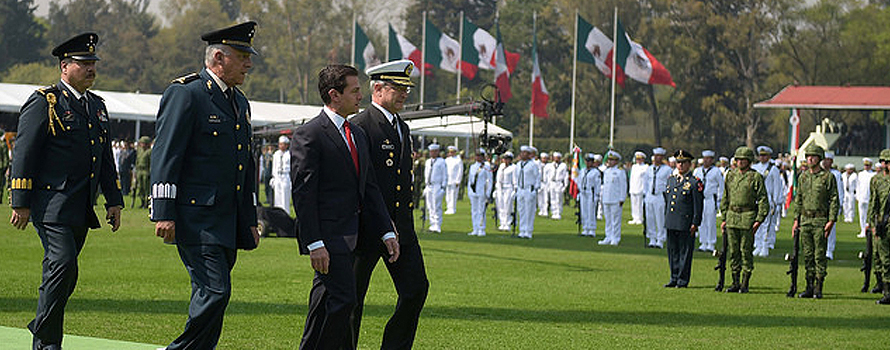
▲The Mexican president on Flag Day, February 2018 [Presidency of the Republic].
article / Valeria Nadal [English version].
Mexico faces a change of sexenio after closing 2017 as the most violent year in the country's history, with more than 25,000 homicides. How has this status been reached ? Can it begin to be resolved in the coming years?
There are several theories about the beginning of drug trafficking in Mexico, but the most widely accepted argues that Mexican drug trafficking was born when Franklin Delano Roosevelt, president of the United States between 1933 and 1945, promoted the cultivation of poppy in Mexican territory with the veiled intention of promoting the production of large quantities of morphine to relieve the pain of U.S. soldiers during World War II. However, drug trafficking was not a serious national problem until the 1980s; since then, cartels have multiplied, violence has increased and crime has spread throughout Mexico.
The new phase of Felipe Calderón
In the fight against drug trafficking in Mexico, the presidency of Felipe Calderón marked a new stage. candidate of the conservative National Action Party (PAN), Calderón was elected for the six-year term 2006-2012. His program included declaring war on the cartels, with a "mano dura" (iron fist) plan that translated into sending the Army to the Mexican streets. Although Calderón's speech was forceful and had a clear goal , to exterminate insecurity and violence caused by drug trafficking, the result was the opposite because his strategy was based exclusively on police and military action. This militarization of the streets was carried out through joint operations combining government forces: National Defense, Public Security, the Navy and the Attorney General's Office (PGR). However, and despite the large deployment and the 50% increase in the expense in security, the strategy did not work; homicides not only did not decrease, but increased: in 2007, Calderón's first full presidential year, 10,253 homicides were registered and in 2011, the last full year of his presidency, a record 22,409 homicides were registered.
According to agreement with the high school of Legal Research (IIJ) of the National Autonomous University of Mexico (UNAM), in that record year of 2011 almost a quarter of the total Mexican population over 18 years of age (24%) was assaulted in the street, suffered a robbery in public transport or was a victim of extortion, fraud, threats or injuries. The fees of violence was so high that it surpassed those of countries at war: in Iraq between 2003 and 2011 there was a average of 12 murders per day per 100,000 inhabitants, while in Mexico that average reached 18 murders per day. Finally, it is worth mentioning that the number of complaints about this indiscriminate wave of violence was quite high leave: only 12% of the victims of drug-related violence reported. This figure is probably related to the high rate of impunity (70%) that also marked Calderón's mandate.
Peña Nieto's new approach
After the failure of the PAN in the fight against drug trafficking, in 2012 Enrique Peña Nieto, candidate of the Institutional Revolutionary Party (PRI), was elected president. With this, this party, which had governed for uninterrupted decades, returned to power after two consecutive six-year periods of absence (presidencies of Vicente Fox and Felipe Calderón, both from the PAN). Peña Nieto assumed the position promising a new approach , contrary to the "open war" proposed by his predecessor. He mainly focused his security policy on the division of the national territory into five regions to increase the efficiency and coordination of operations, on the reorganization of the Federal Police and on the strengthening of the legal framework . However, the new president maintained the Army's employment in the streets.
Peña Nieto's results in his fight against drug trafficking have been worse than those of his predecessor: during his term, intentional homicides have increased by 12,476 cases compared to the same period in Calderón's administration and 2017 closed with the regrettable news of being the most violent year in Mexico to date. With just months to go before the end of his six-year term, and in a last-ditch effort to right the wrongs that have marked it, Peña Nieto brought about the approval of the Internal Security Law, which was voted by Mexico's congress and enacted in December of last year. This law does not remove the military from the streets, but intends to legally guarantee that the Armed Forces have the capacity to act as police, something that previously only had the character of provisional. According to the law, the military participation in daily anti-narcotics operations is not to replace the Police, but to reinforce it in those areas where it is incapable of dealing with drug trafficking. The initiative was criticized by critics who, while recognizing the problem of the scarcity of police resources, warned of the risk of an unlimited military deployment over time. Thus, although Peña Nieto began his term in office trying to distance himself from Calderón's policies, he has concluded it by consolidating them.
|
source: Executive Secretariat, Government of Mexico |
What to expect from the 2018 candidates
Given the obvious ineffectiveness of the measures adopted by both presidents, the question in this election year is what anti-drug policy the next president will adopt, in a country where there is no re-election and therefore every six-year presidential term means a change of face. The three main candidates are, in the order of the polls: Andrés Manuel López Obrador, of the Movimiento Regeneración Nacional (Morena); Ricardo Anaya, of the PAN coalition with the Partido de la Revolución Democrática (PRD), and José Antonio Meade, of the PRI. López Obrador came close to reaching the presidency in 2006 and 2012, both times as candidate of the PRD (he had previously been leader of the PRI); he then created his own party.
Meade, who represents a certain continuity with respect to Peña Nieto, although in the electoral campaign he has adopted a more anti-corruption tone, has pronounced himself in favor of the Internal Security Law: "It is an important law, it is a law that gives us framework, that gives us certainty, it is a law that allows the participation of the Armed Forces to be well regulated and regulated". Anaya has also positioned himself in favor of this law, since he considers that a withdrawal of the Army from the streets would be "leaving the citizens to their fate". However, he supports the need for the Police to recover its functions and strongly criticizes the lack of responsibility of the Government in subject of public security, alleging that Mexico has entered a "vicious circle that has become very comfortable for governors and mayors". In any case, neither Meade nor Anaya have specified what turn they could take that would be truly effective in reducing violence.
López Obrador, from a left-wing populist stance, is a major change with respect to previous policies, although it is not clear how effective his measures could be. Moreover, some of them, such as granting amnesty to the main drug cartel leaders, seem clearly counterproductive. In recent months, Morena's candidate has changed the focus of his speech, which was first centered on the eradication of corruption and then focused on security issues. Thus, he has said that if he wins the presidency he will assume full responsibility for the country's security by integrating the Army, the Navy and the Police into a single command, to which a newly created National Guard would be added. He has also announced that he would be the only one to assume the single command: "I am going to assume this responsibility directly". López Obrador pledges to end the war against drugs in the first three years of his mandate, assuring that, together with measures of force, his management will achieve economic growth that will translate into the creation of employment and the improvement of welfare, which will reduce violence.
In conclusion, the decade against drug trafficking that began almost twelve years ago has result been a failure that can be measured in numbers: since Calderon became president of Mexico in 2006 with the slogan "Things can change for the better", 28,000 people have disappeared and more than 150,000 have died as a result of the drug war. Despite small victories for Mexican authorities, such as the arrest of Joaquin "El Chapo" Guzman during the Peña Nieto presidency, the reality in Mexico is one of intense criminal activity by drug cartels. From the electoral proposals of the presidential candidates, no rapid improvement can be expected in the next six years.

▲Street art in the city of Medellín
ANALYSIS / María Gabriela Fajardo
Colombia experienced on March 11 the first elections held after signature in 2016 of the Peace agreement between the government and the guerrillas of the Revolutionary Armed Forces of Colombia (FARC). These elections to the country's bicameral congress - members of the Senate and the House of Representatives were elected - were the first occasion in which the different ideological sectors could measure their forces without the distortion of an armed struggle in significant parts of the territory. Traditionally, social rejection of the guerrilla campaign has been alluded to as an explanation for why the left in Colombia has usually enjoyed little popular support. Has the arrival of peace changed the correlation of political forces and has it led to an improvement in the electoral results of the left?
To answer these questions, we will examine the results obtained by the different political options, grouped into sections of the ideological spectrum (right, center-right, center-left and left), in the elections to congress held since the beginning of this century. An examination of the political composition of congress over the last decade and average will give perspective to the results of the March 11 legislative elections. These elections meant the integration of the FARC into the Colombian political party system, under a different name - Fuerza Alternativa Revolucionaria del Común - but with the same acronym.
In the 2002-2018 period there were also, in addition to the five elections to the congress, as many presidential elections. The latter are mentioned in the analysis because they help to clarify the contexts, but they are not included in the comparative work , given that the presidential elections are governed by more personalistic dynamics and complex vote transfers take place due to the double round process. The March 11 elections, however, provide considerations for the presidential elections of May 27.
Senate
The Parapolitics scandal distorted the reception of the results of the 2002 legislative elections, after paramilitary chief Salvatore Mancuso claimed that 35% of the elected congress were "friends" of his organization. The right wing, represented by the Liberal Party and the Conservative Party, won 41.1% of the Senate seats. This figure does not include the seats won by other minor political groups, among them Colombia Siempre, whose head of list was the current candidate presidential candidate Germán Vargas Lleras. The left, on the other hand, was quite fractioned, in groups such as Vía Alterna and Movimiento Popular Unido, and obtained 14% of the Senate seats. The center-left won 12.9% and the center-right 7%.
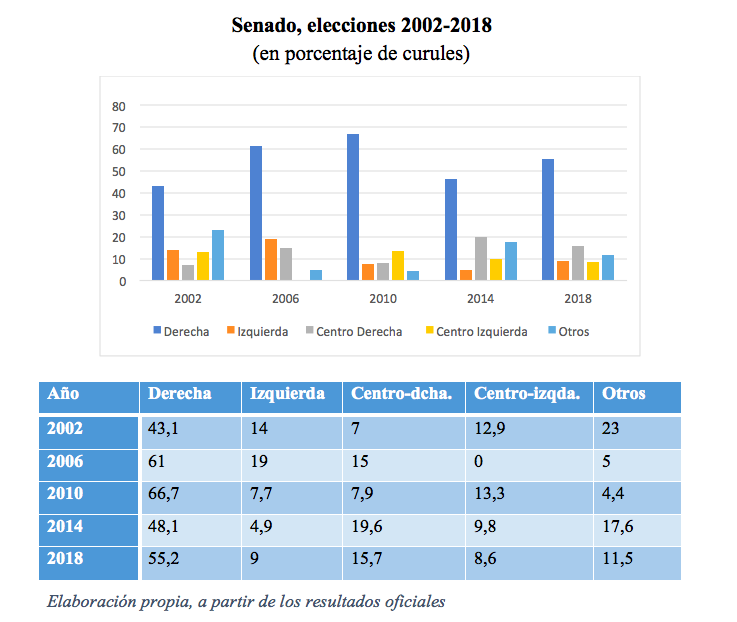 |
In the 2002 presidential elections, held a few months after the legislative elections, Álvaro Uribe became head of state, with the vote of 53.1% of the voters. Uribe ran as an independent candidate , after splitting from the Liberal Party, and had the support of much of the right and center-right, including Cambio Radical, Somos Colombia and the Conservative Party, which then did not participate in the presidential race.
Thus, in the 2006 legislative elections, a new party, the Partido Social de Unidad Nacional (better known as Partido de la U), created by Álvaro Uribe, played a major role. The Partido de la U won the elections, obtaining 20% of the seats: for the first time neither of the two traditional parties (Liberal and Conservative) had won result . The new party was here to stay, so that the right wing was now represented by three parties (de la U, Liberal and Conservative), with 61% of the senators. The left, although it increased to 19% of the Senate seats, was split into several political parties without weight and without the possibility of proposing drastic legislative changes. The center-right, represented by Cambio Radical, was in fourth place, with 15% of seats, while the center-left obtained none.
In 2010 the right wing reached its highest point, with 66.7% of the Senate seats, a figure that includes the three right-wing parties mentioned above and MIRA, a group with a smaller presence. These were moments of political dominance for Uribismo. In the electoral months of 2010, President Uribe was expressing his support to Juan Manuel Santos as candidate presidential. It was thought that he would continue Uribe's policies of confronting the guerrillas and organizing the security forces. However, after coming to power, Santos surprised by disassociating himself from Uribe and opening negotiations with the FARC in 2012, which led to the rupture of the relationship between the two politicians (El periodico, 2017). The strength demonstrated by the right in the 2010 legislative elections was accompanied by a great weakness of the left, which obtained only 7.7% of the Senate seats and would become the perfect ally of President Santos to carry out his diary and his journey towards the political center. The center-left had a representation of 13.3%, thanks to the push of the new Alianza Verde party, and the center-right remained at 7.9%.
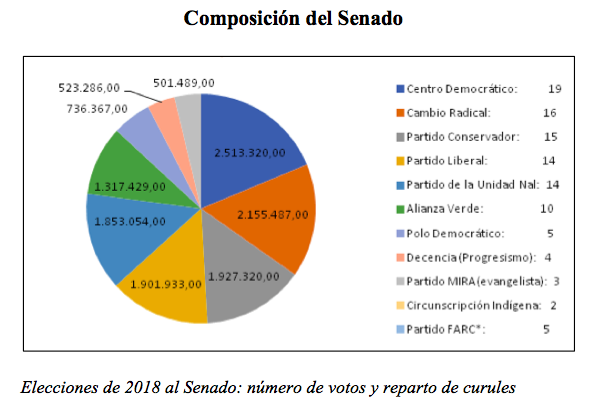 |
The 2014 legislative elections meant the consolidation of a new right-wing party, the Democratic Center, created by Uribe after his separation from the U Party, which had been left in the hands of Santos, who that year would win reelection as Colombian president. The Democratic Center came in second place in the Senate elections, with only one senator less than the U Party (Sanchez, 2018). In 2014, the right went on to control 48.1% of the Senate, from agreement with the ideological realignment of the party system. Thus, several experts came to classify the Partido de la U as center-right, label which they also began to grant to the Partido Liberal, in a political space shared with Cambio Radical; these three parties formed the "Unidad Nacional" (Castillo, 2018). With this, the center-right totaled 19.6% of the seats, while the center-left obtained 9.8%, due to the votes achieved by the Green Party and the Progressives, the latter led by Gustavo Petro, current presidential candidate . The left only reached 4.9%, represented by the minorities of the Polo Democrático, the Unión Patriótica, Marcha Patriótica and the groups that came from the demobilized guerrillas.
In the legislative elections of March 11, there was a reinforcement of right-wing positions, with the return of some parties which in previous elections had slid towards the center-right by defending the negotiation with the FARC and which now wanted to counteract the fear of part of the population of a rise of the radical left, in a very polarized electoral process. Thus, the right rose to 55.2% of the senators, led by those of the Democratic Center, while the center-right fell to 15.9%. The moderate and radical left increased their presence: the center-left rose to 11.5% and the left to 9%. This last percentage does not include the five seats guaranteed to the FARC, which despite not winning any senator electorally, will have those five seats guaranteed by the Peace Accords.
House of Representatives
The results in the 2002-2018 period of the elections for the House of Representatives, held simultaneously with those for the Senate, do not differ much from what was discussed in the previous epigraph; however, they present some variations that should be considered.
The institution was quite affected by parapolitics scandals, a factor that influenced the political polarization of the country, which would be reflected in the elections throughout this period. In 2002, the right won 47% of the seats in the House, with the Liberal Party having the largest representation; the left won 27.1%. From then on, the center-right, which in 2002 obtained 4.2% of the representatives (the center-left took 1.8%) began to take a certain configuration, as the contours of the two traditional parties -Conservative and Liberal- blurred with the division into factions, from which new parties would emerge; this ended the bipartisanship experienced in Colombia throughout the 20th century: the Conservative governed for 48 years and the Liberal for 13.
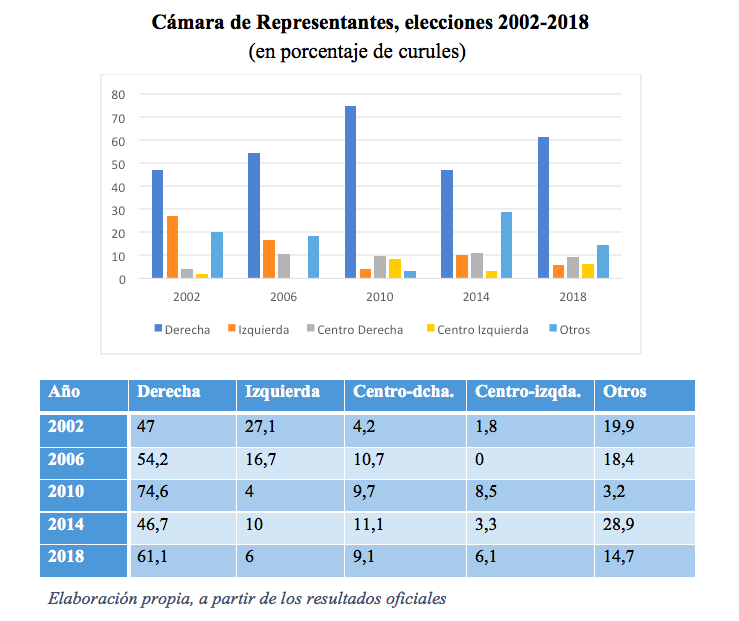 |
The emergence of the Partido de la U, led by Álvaro Uribe and the wide acceptance of his political figure (Uribe became president in 2002 and was reelected in 2006), led for the first time a party other than the two traditional ones to come in second place in the 2006 legislative elections, in which the Partido de la U won 16.7% of the seats in the Chamber, raising the representation of the right to 54.2%. For its part, the left dropped its representation to 16.7% and entered a period of special political weakness (these elections were not good for the center-left either, which did not obtain representation). At a time of President Uribe's successes against the guerrillas, with measures supported by a large part of the population, although not without controversy, the left-wing parties were weighed down by sharing certain ideological assumptions with the guerrillas, as political scientist Andrés Dávila of the Universidad de los Andrés Dávila of the Universidad de los Andres points out.
This dynamic led to an even greater increase of the right wing and a new decline of the left wing in the House of Representatives in 2010, in parallel with what happened in the Senate, in a year in which the candidate promoted by Uribe, Juan Manuel Santos, would also win the presidency. The Partido de la U was ahead of the Liberal Party and the Conservative Party in the House of Representatives, with these three right-wing parties accounting for 74.6% of the seats, the highest percentage of the entire period studied; the center-right party reached 9.7%. For its part, the left, whose largest party was the Polo Democrático, reached only 4%, its worst share in the period, minimally compensated by the maximum representation of the center-right, although this was a modest 8.5%.
The 2014 elections brought with them the presence of a new party headed by Uribe, the Democratic Center, which positioned itself to the right of the previous ones by positioning itself forcefully against the continuation of the peace dialogues with the FARC propitiated by President Santos (El periodico, 2017). The rupture between Santos and Uribe caused their electorate to split, so that in the elections to the House of Representatives the Liberal Party won, followed by the U Party, the Conservative Party and the Democratic Center. Taking into account the shift towards more moderate positions of some of these formations, when grouping them together we have that the right-wing advocates dropped to 46.7% of the seats in the House, while the center-right rose to 11.1%. The left, with the Polo Democrático, improved its representation somewhat to 10%, and the center-left languished at 3.3%.
Four years later, last March 11, the Liberal Party won again the elections to the House of Representatives, followed by the Democratic Center, the Radical Change, the U Party and the Conservative Party. Some of these formations returned during the electoral campaign to clear right-wing positions that they had previously moderated, so that the right wing added 61.1% of the seats (Sánchez, 2018), compared to 6% for the left. For its part, the center-right scored 9.1% and the center-left 6.1%. To these figures must be added the five seats in the House granted by the agreement de Paz to the FARC, which also failed to win any by citizen vote, as in the Senate. With this enlargement, the Colombian bicameral congress goes from 268 to 280 members (the ten members of the FARC party and two that will correspond to the presidential ticket that comes second in the presidential elections).
 |
The division of the left
The analysis carried out allows us to affirm that right-wing political approaches have remained in the majority in Colombia so far this century, as was the case in previous decades, although no longer in the hegemonic framework of two major parties, but of a wider range of partisan options. In a period in which in many other Latin American countries there were turns to the left -notably, the Bolivarian revolutions- Colombia was a clear exception. In this time, the right in Colombia (not including the center-right) has controlled between 43.3% (2002) and 66.7% (2010) of the Senate seats and between 46.7% (2014) and 74.6% (2010) of those in the House of Representatives. In contrast, the left (not including the equally reduced center-left) has remained a minority: it has moved between 4.9% (2014) and 19% (2006) of the Senate, and between 4% (2010) and 27.1% (2002) of the House.
The 2016 Peace agreement and the integration of the FARC into political life have so far not led to a significant electoral boom of the left. In the legislative elections of March 11, 2018, the right actually recovered positions compared to 2014 in the two institutions of the Contreso, while the left, although it certainly improved its presence in the Senate, but far from the levels of 2002 and 2006, instead lost space in the Chamber.
The fear of broad sectors of the population that the political benefits granted to the FARC, such as guaranteed access to media or campaign financing, would contribute to an electoral advance of the ex-guerrillas did not materialize in these elections. The results of the October 2016 plebiscite, which rejected the agreement de Paz (this came into force in 2017 after some changes, without a new plebiscite), were again reflected in the past legislative elections: Colombians oppose the participation of former members of the belligerent group in politics. FARC candidates obtained only 0.28% of the votes. In addition, this party announced days before the legislative elections that it will not run in the presidential elections, for which the maximum leader of group, Rodrigo Londoño, was running as candidate .
Is Colombia a conservative country? Why has the left in Colombia been so weak electorally? These recurring questions about Colombian politics are not easy to answer. "The left is a sector that has traditionally been very much divided among doctrinal tendencies, for strategic reasons and even by personalities", explains Yeann Basset, director of the Observatory of Electoral Processes of the Universidad del Rosario.
It is worth highlighting what Fabio López, author of the book "Izquierdas y cultura política", said in response to the question of whether there is a left in Colombia:
"One thing is that we come from a defeat, internationally thought, of the left, an enormous setback of the workers' movement, a discrediting of socialist ideas, and another thing is the disappearance of the causes, of the structural reasons that motivate at international and national level some leftist ideas, some roots and some justifications, to appeal to the rescue or better restructuring, a new beginning of some leftist approaches in Colombia".
One of the reasons usually given to explain the difficulty of the left in gaining greater support is the negative weight of the guerrilla subversion. In Colombia, after the constant conflicts, massacres and the pain that the armed conflict has left on Colombians, leftist parties have not achieved the support of the society as in neighboring countries since there is a direct association of leftist party with the guerrillas and what comes with them. The arrival of political leaders such as Uribe to the presidency intensified this association and increased the taboo present today in a large part of the citizens of supporting a leftist party. At the same time, the left has not done much to repair this bad image; the great internal fragmentation and differences among political leaders have not helped the training of a solid left with the capacity to increase its representation in the congress.
Opportunity for the presidential election?
The presidential elections on May 27 are an opportunity for the left to improve its electoral results, which in any case could advance in the future to the extent that peace is consolidated and the past of violence can be forgotten.
The political polarization, which on other occasions has harmed the left, this time is assuming a certain unity of this ideological sector around the candidacy of Gustavo Petro, former mayor of Bogota. The celebration on March 11 of primaries on the right, won by the pro-Uribe Iván Duque, and on the left, won by Petro (Sánchez, 2018), have accentuated the polarization for the presidential elections, increasing citizen mobilization (in the legislative elections there were five more points of participation) and attracting media attention to both candidates. Polarization, at the same time, has reduced support to possible centrist alternatives, as divided as the left was before, so that it cannot be ruled out that Petro may go to a second round, on June 17. A victory against the odds for Petro, for which he should attract the bulk of the moderate electorate, would not mean a radical change in legislative policies, as the congress revalidated last March 11 the dominance of the right.
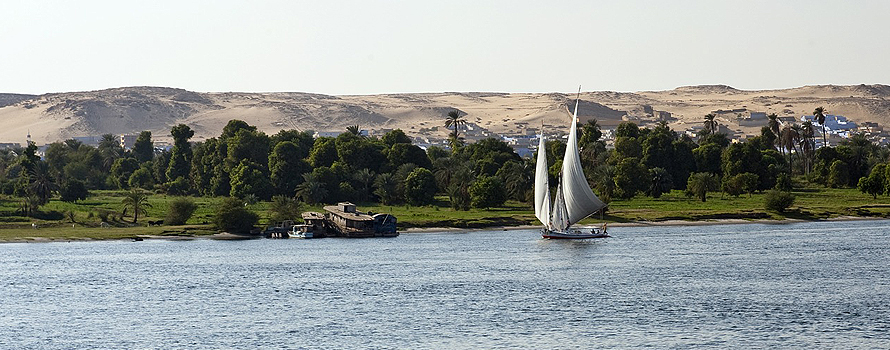
▲Lower Nile River, Egypt [Pixabay]
ANALYSIS / Albert Vidal [English version]
Disputes over control of rivers, lakes, and, in particular, final, are particularly alive today and will intensify in the near future, since, according to the World Health Organization, by 2025 half of the world's population will live in water-scarce areas. Currently, the countries with the most water reserves are Brazil, Russia, the United States, Canada, China, Colombia, Indonesia, Peru, India and the Democratic Republic of Congo. Most water available It is found underground, concentrated in aquifers, or surface water (rivers and lakes). The aquifers with the largest reserves are the Nubian Sandstone Aquifer System (under the Sahara Desert), the Great Artesian Basin (in Australia), and the Guarani Aquifer (in South America). On the other hand, there are a number of rivers in the world that are of exceptional importance, simply because of the enormous amount of population and economic activity that depend on them. Problems arise when these rivers are not part of a single State, but are contiguous or transboundary rivers, and that leads to disputes between some States.
Flashpoints in Asia
Asia is being particularly affected by this problem. There are currently various tensions revolving around water control. One of the most significant cases concerns the use of water from the Indus River, which supports 300 million people and has caused tensions between Pakistan and India. This river is a resource vital for both countries. With the independence of Pakistan, the Indus became a source of disputes. This was addressed by the Indus Water Treaty (1960), which gave India the three eastern tributaries (the Sutlesh, the Ravi and the Beas) and Pakistan the three western rivers (the Indus, the Jhelum and the Chenab). But due to water scarcity, Pakistan has recently protested against the construction of dams on the Indian side of the river (in Indian-administered Kashmir), which restrict the water supply to Pakistan and reduce the flow of the river. India, for its part, defends itself by saying that such projects are covered by the Treaty; Still, tensions don't seem to be abating. For this reason, Pakistan has order the World Bank to appoint the president of an international arbitration tribunal in order to resolve the dispute. This problem of water reserves is at the heart of the confrontation in Kashmir: without an adequate supply, it would not take long for Pakistan to become a desert.
|
Watersheds in Central Asia [Wikimedia Commons–Shannon I] |
Indus River Basin [Wkiwand] |
In Asia, there is also the dispute over the Mekong River, which runs through Cambodia, Vietnam, Laos and Thailand. This conflict revolves around the construction of dams by various countries, as well as the exploitation of the resources provided by the Mekong River. Eleven dams along the river are planned, which would produce a large amount of electricity and be beneficial to some countries, but in turn could threaten the food security of millions of people. The affected countries (Cambodia, Vietnam, Laos and Thailand) formed the Mekong River Commission (MRC) in 1995. This commission was formed in order to promote dialogue and promote the fair and equitable use of the river's waters. The MRC has mediated between countries several times; in 2010 for the construction of a dam by Laos and Thailand, and the same status It happened in 2013. Talks have not been result and there are fears for the lives of millions of people, who could be affected if the conflict escalates.
The ineffectiveness of this body could be summed up as follows: decisions on the construction of dams are made directly without submitting them to the MRC, and construction companies put such pressure on governments that it is very difficult to carry out environmental impact assessments. Moreover, since it is not a binding treaty, members end up ignoring its guidelines and preferring to "cooperate" in a broad sense. In any case, the talks are continuing although, at the moment, the MRC does not seem able to assume the weight of the negotiations. This gives the conflict an uncertain and dangerous future.
A third source of friction is the ex-Soviet region of Central Asia. During the Cold War, these regions shared resources as follows: the mountainous republics (Tajikistan and Kyrgyzstan) had abundant water, and supplied it to the downstream republics (Kazakhstan, Turkmenistan, and Uzbekistan) to generate electricity and irrigate crops. In turn, the downstream republics supplied gas and coal to Tajikistan and Kyrgyzstan during the winter. But when the USSR collapsed, all that changed and there began to be water shortages and power cuts, as these independent countries decided to stop sharing water and energy. As the International Crisis Group think-tank proclaims, "the root of the problem lies in the disintegration of the system of sharing sources imposed by the Soviet Union in the region until its collapse in 1991."
Thus, Kyrgyzstan and Tajikistan have decided to build hydroelectric dams on the Syr Darya and Amu Darya rivers to produce their own energy and thus cope with the constant blackouts (potentially lethal in winter). This, of course, will limit access to water for millions of people living in the other three republics, which has led to small-scale conflicts. Threats have also abounded, such as that of Uzbek President Islom Karimov, who in 2012 said the following: "Water resources could become a future problem that could lead to an escalation of tensions not only in our region, but across the continent"; He added: "I won't name specific countries, but all of this could deteriorate to the point where the result It wouldn't just be a confrontation, it would be wars." Despite the threats, the projects have continued on their way, and therefore an increase in tension in the region can be expected.
|
The Nile Course [Wikimedia Commons–Yale Environment 360] |
Mekong River Basin [Wikimedia Commons–Shannon I] |
Control of the Nile
The Nile River appears as source of tension between various African countries. To understand the existing problem, we must go back more than a century. As early as 1868, Egypt attempted to occupy Ethiopia in order to gain control of the Nile. In 1929 , agreements were signed during the colonial era, in which the waters of the Nile were divided. In these agreements (which were reaffirmed in 1959), Egypt obtained most of the water for its use, while Sudan obtained a small share. The remaining 9 countries in the Nile basin were removed from the treaty. At the same time, Egypt was allowed to build projects on the Nile River while the rest of the riparian countries were forbidden to do the same without Egypt's permission.
In 1999, the Nile Basin Initiative was created: a commission charged with organizing a fair distribution of the Nile's water and resources. But as it did not have the expected effect, in 2010 the agreement of Entebbe (for Ethiopia, Rwanda, Uganda, Kenya, Tanzania and Burundi). This agreement, deeply disputed by Egypt and Sudan, allows riparian countries to build dams and other projects, thus breaking the restrictions imposed by colonial treaties. Moreover, this has shifted the balance in the region, as Egypt and Sudan have lost their monopoly on the Nile's resources.
It is vital to understand the status of these actors. The Nile rises in several countries, and ends up passing through Sudan and Egypt to flow into the Mediterranean Sea. Egypt, in particular, is a country totally dependent on the Nile River. It receives more than 90% of its fresh water from this river, and its industry and agriculture need the Nile to survive. Until a few years ago, thanks to colonial treaties, Egypt had exercised a monopoly on the use of water; But recently, the status it's changing.
Therefore, the confrontation has basically arisen between Egypt and Ethiopia (where the Blue Nile is born). The latter is a country with more than 100 million inhabitants, which in 2011 had a project of dam construction: the Grand Ethiopian Renaissance Dam (GERD). With an investment of 4,700 million dollars, this dam would solve Ethiopia's energy deficit, and would eventually turn this country into a net exporter of electricity (it would produce 6,000 MW per year). The downside is that the dam will be fed with water from the Blue Nile, a tributary of the Nile River. The danger of evaporation of more than 3 trillion cubic meters per year and the reduction of the flow rate to fill the reservation it could catastrophically affect Egypt. In addition, the dangers arising from the overuse of water are compounded by population growth and the demand for better redistribution of water among riparian countries.
This issue has led to tensions between the two countries: in 2010 an email from a senior Egyptian commander was leaked to Wikileaks stating: "We are discussing military cooperation with Sudan against Ethiopia, with plans to establish a base in Sudan for Egyptian Special Forces with a view to attacking the country."project GERD." Egypt also thought of preparing support for proxy rebel groups in Ethiopia, to destabilize the government. In any case, we must bear in mind that Egypt has always tended to use aggressive rhetoric towards all issues related to the Nile (source of life, the engine of its Economics), but in reality the nation of the pharaohs is not in a position to launch armed actions, since its domestic problems have worn down the country, thus losing its position of clear predominance in the region.
But not all the future is so bleak. In March 2015 , a agreement A preliminary agreement between Egypt, Ethiopia and Sudan on the Renaissance Dam and the sharing of water, accepting Ethiopia's right to build the dam without damaging the water supply of Egypt and Sudan. Although these two countries are alarmed at what will happen once the reservation This is a first step towards an era of cooperation. Abdel Fattah el-Sisi himself (Egypt's president) said at the convention: "We have chosen to cooperate and trust each other, for the sake of the development". Finally, in November of the same year, it was not possible to approve an independent commission of inquiry to look at the consequences of the dam, since after Sudan accused Egypt of using part of the Sudanese quota, a war of declarations began, which jeopardized the fragile cooperation between these countries.
Such cooperation in the field of water resources will have a beneficial impact in many other areas and, although a failure of the negotiations cannot be ruled out, it is likely that thanks to the construction of the GERD and regional cooperation, the ties between these countries will become stronger, which can mark the starting point of a new era of peace and peace. development in this region.
A case of cooperation: the Paraná
The Paraná, a border and cross-border river that rises in Brazil and crosses Paraguay to flow into the Rio de la Plata, is a very different example. Its basin is linked to the Guarani Aquifer (one of the largest water reserves in the world), and that is a guarantee of the large volume of water that this river has throughout the year. For this reason, many hydroelectric power plants have been built, taking advantage of waterfalls and rapids. On the other hand, the importance of this river on a political and economic level is core topic; the Paraná and the La Plata Basin feed the most industrialized and populated area of South America. That is why cooperation has been particularly important.
|
The Paraná, central axis of the La Plata basin [Wikimedia Commons–Kmusser] |
The Itaipu Dam (the second largest in the world and the first in world production) is a binational dam, built by Paraguay and Brazil. It was the result of intense negotiations (not always easy), and now produces an average of 90 million MWh (megawatt-hours) per year. Even so, there was not always concord between Paraguay and Brazil: in 1872 disputes over borders began. After many useless agreements, it was agreed to flood the disputed territories and create a hydroelectric dam. The reluctance that the initiative aroused in Argentina, because the regulation affected the flow that, downstream, would continue to the Río de la Plata, resulted in a three-way pact in 1979. In 1984 the dam became operational. Today it is administered by the Itaipu Binational Entity, a business public-private between Paraguay and Brazil, and supplies more than 16% of the total energy consumed in Brazil, and more than 75% of that consumed in Paraguay. Although the environmental impact was great, Itaipu has promoted campaigns to maintain biological reserves and protect fauna and flora. In addition, it has reforested large areas around the reservoir, and ensures the quality of the water.
This is a clear example of the benefits that can be brought by a reasonable and shared use between countries that decide to cooperate. Thus, countries that are parties to some of the current controversies should look to these examples of behaviour which, although not perfect, can be learned a great deal from them.
Although water can be the source of disputes between peoples and nations (such as the cases cited), it also offers very advantageous opportunities (what happened on the Paraná River or the Nile) for countries that manage to cooperate. This cooperation, initiated to avoid conflicts over water, can lead to new stages of harmony and strengthen trade, political and security relations. Is core topic, then, to show how an attitude of willingness to negotiate and cooperate will always have positive consequences for countries that share river flows.
[Michael Reid, Forgotten Continent: A History of the New Latin America. Yale University Press, New Haven, 2017. 425 pages]
review / María F. Zambrano
The recent history of Latin America has a lot of progress, although sometimes it only transcends a few steps backwards. In addition to the important changes that have occurred since the 1980s, when the region embraced democracy, began to overcome economic protectionism and tamed the problem of inflation, there has been a more recent period of economic acceleration – the so-called golden decade, due to the commodity boom – which between 2002 and 2012 has led to a B Social impulse: 60 million people escaped poverty in those years, so that, although great inequalities still exist, at least the class average It now extends to 50% of the population. This has generated better educated societies, which have recognized the primacy of law over the paternalism of the caudillo. But the large revenues that many states earned in that golden decade also led to negative rates.
This moderate optimism about Latin America – without ignoring the difficulties, but without ignoring the progress made – is conveyed in the book Forgotten Continent: A History of the New Latin America, by Michael Reid. publisher of Latin America in The Economist, where he writes the column Bello. A correspondent for nearly 35 years in the region, where he has lived most of this time, Reid is one of the best voices in the world. knowledge about the multiple continental reality. Fruit of that experience staff it's Forgotten Continent, which Reid published in 2007 (then under the subtitle "The Battle for the Soul of Latin America") and which he now offers again in a revised and updated edition, with extensive changes from the first version.
What has happened in Latin America in the last ten years for Reid to see the need for a new presentation of your book? Although there are several elements, such as the end of the commodity boom, which has brought economic difficulties to some countries, and certain changes in political orientation (Kirschner for Macri, or Temer for Rousseff), perhaps the most notable thing is that, in democratic terms, Latin America is seen today with less hope than a decade ago. Ten years ago, the new left-wing populism might have seemed like a mere parenthesis in the progressive democratic consolidation of Latin American societies; Today, certainly, Bolivarianism has already shown signs of failure, but it may have greater continuity than expected by inserting itself with the current of populism of various kinds that emerges in many other parts of the world.
Reid notes the failed path taken by Chávez, also followed by other neighboring leaders of the same stripe: "There are lessons for the region in the catastrophic failure of Chavismo. An accident in history – the rise in the price of oil from 2001 onwards – gave for a time spurious plausibility in some places to an alternative course to which Latin Americans seemed to have turned their backs not so long ago. The 'Bolivarian alternative' was based on erroneous premises (...) In their enchantment with Bolivarianism and renewed regard for Cuba, much of the left forgot the abiding lessons of the end of the Cold War: that central planning had failed and that communism was tyranny, not liberation. In any case, the Bolivarian experience has shown that Latin America did not enter an era of assured democracy at the end of its military dictatorships, just as we now see that neither did the rest of the world with the fall of the Berlin Wall, despite the perception at the time. The risk in the region may be greater, due to the persistence of strong social differences: as Reid puts it, Chavismo is "another reminder that extreme inequality offers fertile ground for populism."
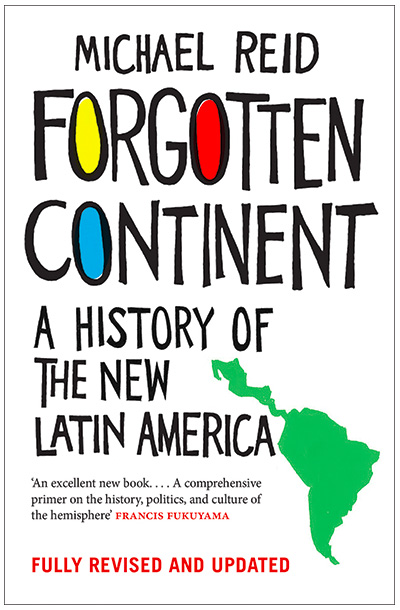 |
Challenges ahead
In a post-Chávez and post-commodity price boom era, Latin America faces a series of challenges, which certainly go back a long way but in some cases are more urgent. Twice as muchgoal to achieve strong institutions and a development An economic and sustainable approach involves solving important challenges, among which Reid highlights several.
One of them is security. Crime and violence have become an epidemic. In 2013, eight of the ten countries and 42 of the 50 most violent cities in the world, outside of war theaters, were in the region. Reid points to the need for territorial control by the armed forces, the professionalization of police forces, closer cooperation between the police and judges, and clear accountability of these bodies to society.
Other challenge is the consolidation of the new class average. There is progress in the Education primary and secondary, but the preparation of both students and teachers lags far behind their peers in developed countries. In the report PISA in 2015, 15-year-old Latin American students were in the bottom third of the world rankings. If the status does not evolve favourably with an increase in the quality of the teaching In the public sector, Reid warns, private entities would become the first alternative of the new social stratum, which would even be subjected to indebtedness without quality guarantees. It's a phenomenon that also occurs in health care.
In the fight against social inequality, many governments have promoted various formulas of Conditional Transfer of Resources (TCR), which are programs of attendance They seek to raise standards of attitudes, such as the enrolment of children in school, in exchange for subsidies. A number of programmes have rightly contributed to the development But in many cases they transfer resources without achieving long-term progress, as well as becoming in certain countries a clear cultivation of a captive vote. By having two parallel social security systems, the government is taxing the formal sector, while subsidizing the informal sector.
Hope
To overcome these challenges, Forgotten Continent raises the need to advance regional integration, the diversification of the Economics and overcoming political dogmatism. Thus, true regional integration would allow for a skill that would stimulate economies of scale and regional supply chains. To overcome, at least in part, the natural barriers to such integration, real investment in infrastructure beyond the current 3% of GDP is needed.
Commodities will continue to be an important economic driver of the region, but they should not be the only one. Agricultural production should provide a added value, derived from the application of innovative technologies, such as the advances that are being made in Argentina and Brazil with "direct seeding" and "precision agriculture". This requires an increase in investment in research and development, which today is only 0.5% of GDP. Latin America also has multiple natural resources that are conducive to the development of the development tourism, or the expansion of manufacturing industries.
The author proposes to break with the discussion between the unfettered free market and protectionism, and stop feeding the corporatist culture of seeing power as a heritage staff. "To get there requires a new subject In the face of the polarization and confrontation offered by populists (and sometimes by their opponents), Latin America needs consensus-building, where the state, the private sector, and civil society work together to set medium-term goals and hold the government accountable for their fulfillment."
These propositional elements of Reid come at the end of a book that is above all a description of the soul of Latin America. This is a continent that has not been poor enough, dangerous enough, or economic enough to attract international attention. Hence the degree scroll of the book. It begins by exposing the structural, geographical and cultural difficulties that the region has had to face in its attempt to establish lasting democracies and overcome its imbalances. It continues with an analysis of political and economic cycles, from independence to the last dictatorships. And finally it concludes with a diagnosis. Although Latin America's problems were already well diagnosed in the first edition, ten years ago, it is in this final part of the book that the author has turned the most pages. His conclusion doesn't vary much, but the tone is slightly more somber; however, Reid prefers to end the story with the same quotation Argentinian liberal Bautista Alberdi: "Nations, like men, do not have wings; They make their journeys on foot, step by step."
ESSAY / Martín Villegas Jordán
The concept of humanity is a contemporary idea that took shape just recently. Many say that it took place after the conference of Yalta in 1945[1]. In other words, this concept was beginning to be conceived by one of the three leaders that shaped today's world, U.S. President Franklin D. Roosevelt. During the conference, the three big leaders of the world, who at the time were British Prime Minister Winston Churchill, Soviet Premier Joseph Stalin, and U.S. President Roosevelt[2], came to an agreement (mostly encouraged by Roosevelt) that would eventually give birth to the United Nations. Now it's vital to know that this intergovernmental organization is intricately composed of the idea of a global union.
Moreover, the concept of a global union, of the United Nations, embodies the idea of humanity as universal. It encompasses the idea of humanity as a composition of every existing nation. In short, humanity eventually becomes the nation for all human beings, a nation of nations. And this is where Mr. Roosevelt plays a relevant role when he said: "A nation that destroys its soils destroys itself. Forests are the lungs of our land, purifying the air and giving fresh strength to our people"[3].
It's possible, then to say that the previous century was the time when global issues were given the attention that they deserved. For instance, the National Aeronautics and Space Administration (NASA) marks 407.62 parts per million of carbon dioxide of earth and 0.99 degrees Celsius for the temperature anomaly of 2016 (denoting that year as one of the sixteen warmest years since 2001)[4].
Besides, humanity faces dramatic gaps in temperature. Take a look, for instance, at Oymyakon, Russia, where the temperature is normally around negative fifty-four degrees Celsius[5]. Now, looking at the Sahara desert, it's inhabitants face temperatures of fifty-nine degrees Celsius or more.
Moreover, climate change becomes a more pressing matter when looking at two reports of the NASA. On the first hand, the one titled "November of 2017 was the third warmest November on record" states: "The last three Novembers — 2015, 2016, and 2017 — are the three warmest in the entire modern record." [6]. On the other hand, the one titled "Greenland melt speeds East Coast sea level rise" states the following: "the Greenland and Antarctic influence alone would account for an increase in the rate of sea level rise on the East Coast of 0.0016 to 0.0059 inches (0.04 to 0.15 millimeters) each year, varying by location. That's equivalent to 7.8 inches (0.2 meters) of sea-level rise on the northern East Coast over the next century, and 2.5 feet (0.75 meters) in the south, though the estimates are quantitative and not an attempt at an actual projection"[7].
Still, having such a clear evidence of climate change, it is true that legislators choose to deny this, which actually ends up convincing people. This is evident, for example, when analyzing the politics of the current President of the U.S., Donald Trump. For instance, during his campaign (when addressing the mining community) he said: "If I take hairspray, and I spread it in my apartment, which is all sealed, you are telling me that affects the ozone layer. I say "no way folks" (...) that is like all of the rules and regulations you people have in mines"[8].
What is also true about this blind humanity is that the many pronunciations of the United States' president have a strong pull towards decisions that countries in Mesoamerica and South America take. Take Colombia, for instance. Now, this country had banned the eradication of illicit cultivations of drugs by aspartame but president Trump has been insisting and pushing for this harmful way for the environment and for humans that can possibly live by the crops[9]. Furthermore, it can be said that pressure from the North American country has not been light in the rest of Latin America.
Summing up, it is clear that America is clearly in need of renewable energy sources no matter what the political discourse states. Specifically, America is in need of "those sources of energy obtained from natural means that are renewable and susceptible to indefinite use"[10]. Take, for instance, countries like Brazil, Mexico and Argentina, which are called to be the future in the study of sustainability due to their "geographical and climatological conditions, which make Latin America one of the regions that pose high potential from renewable energy sources"[11]. Furthermore, these countries are pioneer in the ambits of wind, hydropower, and large-scale soy growing, which makes them subject to the advantages that the implementation of renewable energy poses. In fact, experts Emma Mendoza and Vadim Pérez at the University of Chile insist on these advantages being: (1) the potential for creating almost six times of what global consumption is today (2) the production being national (3) the de-centralized consumption, meaning that energy is consumed in the place where it is produced and there is no necessity to export (4) the hygiene of the obtained energy, meaning that there are no significantly harmful remnants (5) and the investment in high tech industry[12].
In fact, in America there has been an exponential growth in the implementation of renewable energy projects since the implementation of the Paris 2015 accords on Climate Change. Such growth though, is directly proportional with the increments in federal or particular centralized companies with strong governmental support [13].
In Latin America the three pillars in the ambit of sustainability are the eolian industry, the hydroelectric industry, and the industry of the monocultures[14]. Of the countries previously mentioned, for example, Brazil and Mexico specialize in the eolian industry, Brazil also plays an important role in hydropower development, and Argentina leads the large scale soy growing. It is of vast importance though, to previously mention the fact that the development of renewable energies is not the only factor that is taken into account when analyzing the partner-scientific field of sustainable energies. Then, in addition to the plain development of these energies, the social movements that emerge in response to the expansion of these industries play a key role for the future of sustainable energies in the world.
It is interesting to look at each of the fields with important developments in America. Firstly, taking a close look at how the wind power is transformed in renewable energy and the toll that it has within a partner-Economic Sphere. Now, this type of energy is the least efficient between the three types analyzed in this paper because it has the least impact on the environment and on society. However, the two countries that contribute primarily are Brazil and Mexico, respectively, with a generation of 256 MW and 88 MW[15]. Mainly, the power generated in each country is based upon eolian parks built on the appropriate territories. For example, Brazil's main park is found in the municipality of Osório and it includes three projects that sum a generation potential of 150 MW. Unfortunately, the social outcome of eolian implementation has been negative. Experts Mendoza and Pérez state that the probable origin for the social unrest is the government for ignoring the process of negotiation between enterprises and local habitants. Also, the clean energy enterprises are paying only 1.5% of the incomes to the landowners that put their terrains for the disposition of these enterprises. Besides, other social unrest is the co-ownership of most of the terrains, presenting more negotiation difficulties between enterprises and landowners. In short, the main opponents (via judicial demands) in Mexico are: "the Union of Indigenous Communities of the Northern Zone of the Isthmus" and "the Topeyec and Gubiña Human Rights Centers"[16]. As if there was not enough opposition already, these denunciators even claim that some of the acts committed by the enterprises are unconstitutional.
Secondly, it is important to look at hydroelectric power principally developed in Brazil because hydroelectricity is the principal source of electricity generation in Latin America. For example, Brazil's hydroelectric power in 2006 accounted for 60% of the total of electricity generated. Furthermore, hydroelectricity can be developed under low costs of operation and high efficacy. It is also important to look at hydroelectric power in Brazil as a pioneer due to the first efforts of implementation that have been present in the country since 1970.
Thirdly, the large-scale soy production can also be considered as a renewable energy source.
[1] History.com Staff. "Yalta Conference." History.com, A&E Television Networks, 2009, www.history.com/topics/world-war-ii/yalta-conference.
[2] Ibid.
[3] "151 Inspiring Environmental Quotes." Conserve Energy Future, 15 Apr. 2017, www.conserve-energy-future.com/inspiring-environmental-quotes.php.
[4] "Global Climate Change." NASA, NASA, 2 June 2014, climate.nasa.gov/.
[5] "Oymyakon, Russia Weather Forecast and Weather Conditions - The Weather Channel." The Weather Channel, 19 Jan. 2018, weather.com/es-ES/tiempo/hoy/l/63.46,142.77.
[6] "November 2017 Was the Third Warmest November on Record." NASA, NASA, 18 Dec. 2017, climate.nasa.gov/news/2666/november-2017-was-the-third-warmest-november-on-record/.
[7] "Greenland Melt Speeds East Coast Sea Level Rise." NASA, NASA, 13 Nov. 2017, climate.nasa.gov/news/2651/greenland-melt-speeds-east-coast-sea-level-rise/.
[8] Mischegoss. "Donald Trump Talks Hairspray and Ozone." YouTube, YouTube, 5 May 2016, www.youtube.com/watch?v=eU2p6YakNJg.
[9] Cosoy, Natalio. "Astonishment In Colombia By Donald Trump's Threat To Increase In Coca Cultivation - BBC Mundo." BBC News, BBC, 14 Sept. 2017, www.bbc.com/mundo/noticias-america-latina-41275301.
[10] Mendoza, Emma and Pérez, Vadim. Renewable Energy and Social Movements in Latin America. Institute of programs of study International – Universidad de Chile. 2010.
[11] Ibid.
[12] Ibid.
[13] Ibid.
[14] For more information of the forms of renewable energy consult: "Renewable Energy Explained." Renewable Energy Sources - Energy Explained, Your Guide To Understanding Energy - Energy Information Administration, U.S. Energy Information Administration, 1 June 2017, www.eia.gov/energyexplained/?page=renewable_home.
[15] MW means mega watts. For more information go to the following citation: -guide-
[16] Mendoza, Emma and Pérez, Vadim. Renewable Energy and Social Movements in Latin America. Institute of programs of study International – Universidad de Chile. 2010.

